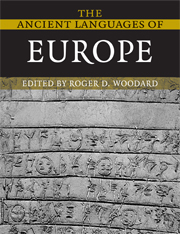Book contents
- Frontmatter
- Contents
- List of figures
- List of tables
- List of maps
- List of contributors
- Notes on numbering and cross-referencing
- List of abbreviations
- Preface
- Preface to the first edition
- 1 Language in ancient Europe: an introduction
- 2 Attic Greek
- 3 Greek dialects
- 4 Latin
- 5 Sabellian languages
- 6 Venetic
- 7 Etruscan
- 8 Continental Celtic
- 9 Gothic
- 10 Ancient Nordic
- Appendix 1 Indo-European
- Appendix 2 Full tables of contents from The Cambridge Encyclopedia of the World's Ancient Languages, and from the other volumes in the paperback series
- Index of general subjects
- Index of grammar and linguistics
- Index of languages
- Index of named linguistic laws and principles
10 - Ancient Nordic
Published online by Cambridge University Press: 01 September 2010
- Frontmatter
- Contents
- List of figures
- List of tables
- List of maps
- List of contributors
- Notes on numbering and cross-referencing
- List of abbreviations
- Preface
- Preface to the first edition
- 1 Language in ancient Europe: an introduction
- 2 Attic Greek
- 3 Greek dialects
- 4 Latin
- 5 Sabellian languages
- 6 Venetic
- 7 Etruscan
- 8 Continental Celtic
- 9 Gothic
- 10 Ancient Nordic
- Appendix 1 Indo-European
- Appendix 2 Full tables of contents from The Cambridge Encyclopedia of the World's Ancient Languages, and from the other volumes in the paperback series
- Index of general subjects
- Index of grammar and linguistics
- Index of languages
- Index of named linguistic laws and principles
Summary
HISTORICAL AND CULTURAL CONTEXTS
Germanic languages prior to AD 500 are attested in two major types of documents, the Gothic Bible translation and runic inscriptions. The bulk of the runic inscriptions are in a language different from Gothic. Most of them are found in Scandinavia, but there is some controversy as to whether the language represents a common Northwest Germanic stage or a separate North Germanic variety (see §1.2). Without further implications and without prejudice in favor of one or the other view, I will henceforth refer to this language as Ancient Nordic.
Prehistory
There is considerable controversy over the absolute chronology of the Indo-European settlement of Northern Europe and of the development of a separate branch of Germanic languages. But most archeologists and historical linguists seem to have reached the consensus that southern Scandinavia and northern Germany were inhabited by speakers of an Indo-European language by the beginning of the third millennium BC (Østmo 1996), and that a distinct branch of Indo-European had evolved by c. 500 BC. From this region the Germanic-speaking people spread north into Sweden and Norway and south into the European continent.
The Germanic area was never politically unified; there has never been a Germanic nation (Haugen 1976:100). The Germanic-speaking people were farmers and cattle-herders organized in loosely knit bands of extended families and clans. During the late Roman period, pre-Christian Scandinavia was a stable society with a strict social hierarchy. Marriage, funerals, and inheritance were conducted according to fixed laws and regulations (Grønvik 1981).
- Type
- Chapter
- Information
- The Ancient Languages of Europe , pp. 215 - 229Publisher: Cambridge University PressPrint publication year: 2008
- 2
- Cited by



